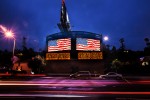Gareth Walsh wanted to put a glitch in Sunset Boulevard’s typical landscape of billboards and advertisements.
He visualized a moving installation that would disrupt the strip’s static signage and make passers-by reconsider their political and urban surroundings.
“You have to create something that is a surprise to see in that context,” Walsh said. “I wanted to break the billboard.”
Walsh, who earned his MFA in Design | Media Arts at UCLA in 2007, created a digital video of a glitching American flag to adorn a billboard on the exterior of 1 OAK, a night club on Sunset Boulevard. Theo Triantafyllidis, a 2016 UCLA alumnus, created a video piece “Prometheus,” which features clips of a pigeon picking at a pretzel, on a billboard just a mile west. Mounted on July 1, the short video clips will remain on the Sunset Strip billboards until Aug. 31.
[Related: UCLA professor’s billboard art piece frames road to Coachella]
However, Walsh said he did not know what to apply his glitch concept to until after the 2016 presidential candidate elections. He said he noticed how the election results and the new administration caused points of rupture within the American people, politics and the country as a whole.
“I didn’t really have a context for the glitch until the election, and I felt that broken down system in the world around me,” Walsh said. “America is in a state of glitch.”
Every 13 minutes, the billboard’s usual cycle of advertisements is interrupted by a one-minute video of a glitching American flag. The video gradually builds up to the glitch as the flag waves smoothly, before switching to inverted color, growing pixelated, flashing four flags at once or featuring a hazy outline of a figure making hand gestures, speaking and pointing.
Walsh said “Glitch” aims to address the feelings of tension that arose from the new administration’s early decisions, such as those concerning immigration laws.
“Someone was voted in legally, and it caused such a reaction in those that voted the other way, and the decisions that the Republicans were making were causing so much tension,” Walsh said.
But Walsh said he wants viewers to interpret his piece on their own. The viewer might see the image as breaking down or building itself back up depending on which end of the voting spectrum they affiliate with, he said.
Jessica Rich, the curator for the electronic billboards on Sunset Boulevard, said she thinks Walsh’s use of the country’s flag to demonstrate a sense of being out of sync is elegant.
“Rather than punch me in the face with it, it’s so subtle that you’re driving along and you’re like, ‘Wait, something’s wrong,’” Rich said. “And that’s what the glitch does – it’s an entire artistic language that causes you to stop and reassess what you’re seeing.”
A mile west from Walsh’s “Glitch” is Triantafyllidis’ billboard installation “Prometheus.” The piece features a simulation of a pigeon pecking at a pretzel on a city sidewalk decorated with props such as traffic cones, cigarette butts or coins. The simulation can culminate in a number of amusing scenarios depending on how the pretzel and pigeon interact with each other and the surrounding objects. Some examples include the pretzel getting stuck inside a traffic cone, the pigeon picking on a cigarette bud or both of them doing circles around a stop sign.
Triantafyllidis’ piece references the ancient Greek myth of Prometheus, a Titan who stole fire from the gods and was sentenced to have his liver eaten daily by an eagle for eternity. Triantafyllidis’ contemporary adaptation uses common city subjects to present the myth; the pigeon, like the eagle from the myth, punishes the pretzel by trying to eat it for all of eternity.
Triantafyllidis said the piece manifests his reflection on how technology has evolved from fire and its continuing impact on life today.
“I’ve been working with art and technology my whole practice, so it’s always interesting for me to look back at what technology is and how it began,” he said.
Rich said digital artwork on billboards like those on Sunset Boulevard reach new audiences who might not frequent traditional art institutions. She added she thinks the billboards provide access to a wider, more diverse audience by using the emerging platform of digital art.
“I think this is the future,” Rich said. “This is a way to make someone think and stop, touch someone and possibly change a life, possibly open a mind.”
